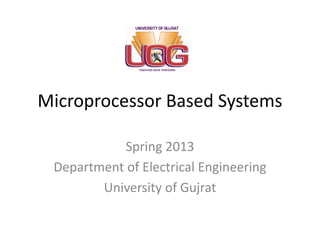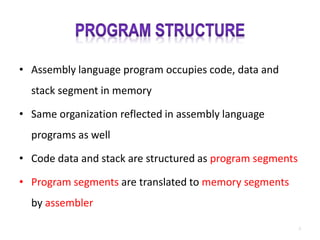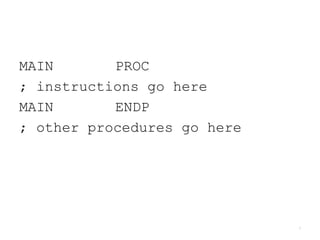Assembly Language Programming By Ytha Yu, Charles Marut Chap 4 (Introduction to IBM ec Assembly. Language)
- 1. Microprocessor Based Systems Spring 2013 Department of Electrical Engineering University of Gujrat
- 2. • Assembly language program occupies code, data and stack segment in memory • Same organization reflected in assembly language programs as well • Code data and stack are structured as program segments • Program segments are translated to memory segments by assembler 2
- 3. Size of code and data, a program can have is determined by specifying a memory model using .MODEL directive MODEL memory_model Model Description SMALL code in one segment data in one segment MEDIUM code in more than one segment data in one segment COMPACT code in one segment data in more than one segment LARGE code in more than one segment data in more than one segment no array larger than 64k bytes HUGE code in more than one segment data in more than one segment arrays may be larger than 64k bytes 3
- 4. • A program’s data segment contains all the variable definitions. • Constant definitions are often made here as well, but they may be placed elsewhere in the program since no memory allocation is involved. .data directive to declare a data segment .DATA WORD1 DW 2 WORD2 DW 5 MSG DB ‘THIS IS A MESSAGE’ MASK EQU 10010111B 4
- 5. • The purpose of the stack segment declaration is to set aside a block of memory (the stack area) to store the stack. • The stack area should be big enough to contain the stack at its maximum size. .STACK 100H • If size is omitted, by default 1kB is set aside 5
- 6. • The code segment contains a program’s instructions. .CODE name • Inside a code segment, instructions are organized as procedures. name PROC ; body of the procedure name ENDP • The last line in the program should be the END directive, followed by name of the main procedure. 6
- 7. MAIN PROC ; instructions go here MAIN ENDP ; other procedures go here 7
- 8. .MODEL SMALL .STACK 100H .DATA ; data definitions go here .CODE MAIN PROC ; instructions go here MAIN ENDP ; other procedures go here END MAIN 8
- 9. • CPU communicates with the peripherals through IO ports – IN and OUT instructions to access the ports directly • Used when fast IO is essential • Seldom used as – Port address varies among compluter models – Easier to program IO with service routine 9
- 10. IO Service routines BIOS routines Interact directly with ports Stored in ROM DOS routine Carry out more complex tasks e.g. printing a character string 10
- 11. • I/O service routines The Basic Input/Output System (BIOS) routines The DOS routines • The INT (interrupt) instruction is used to invoke a DOS or BIOS routine. • INT 16h – invokes a BIOS routine that performs keyboard input. 11
- 12. • INT 21h may be used to invoke a large number of DOS functions. • A particular function is requested by placing a function number in the AH register and invoking INT 21h. 12
- 13. Input: AH = 1 Output: AL = ASCII code if character key is pressed = 0 if non-character key is pressed 13
- 14. MOV AH, 1 ; input key function INT 21h ; ASCII code in AL 14
- 15. Input: AH = 2 DL = ASCII code of the display character or = control character Output: AL = ASCII code of the display character or = control character 15
- 16. • MOV AH, 2 ; display character function MOV DL, ‘?’ ; character is ‘?’ INT 21h ; display character 16
- 17. ASCII Code HEX Symbol Function 7 BEL beep 8 BS backspace 9 HT tab A LF line feed (new line) D CR carriage return (start of current line) 17
- 18. • ECH.ASM will read a character from the keyboard and display it at the beginning of the next line. • The data segment was omitted because no variables were used. • When a program terminates, it should return control to DOS. • This can be accomplished by executing INT 21h, function 4Ch. 18
- 19. TITLE ECHO PROGRAM .MODEL SMALL .STACK 100H .CODE MAIN PROC ; display prompt MOV AH, 2 ; display character function MOV DL, '?' ; character is '?' INT 21H ; display it ; input a character MOV AH, 1 ; read character function INT 21H ; character in AL MOV BL, AL ; save it in BL ; go to a new line MOV AH, 2 ; display character function MOV DL, 0DH ; carriage return INT 21H ; execute carriage return MOV DL, 0AH ; line feed INT 21H ; execute line feed ; display character MOV DL, BL ; retrieve character INT 21H ; and display it ; return to DOS MOV AH, 4CH ; DOS exit function INT 21H ; exit to DOS MAIN ENDP 19
- 20. 20
- 21. • An editor is used to create the preceding program. • The .ASM is the conventional extension used to identify an assembly language source file. 21
- 22. • The Microsoft Macro Assembler (MASM) is used to translate the source file (.ASM file) into a machine language object file (.OBJ file). • MASM checks the source file for syntax errors. • If it finds any, it will display the line number of each error and a short description. • C:>MASM File_Name; 22
- 23. • The Link program takes one or more object files, fills in any missing addresses, and combines the object files into a single executable file (.EXE file) • This file can be loaded into memory and run. • C:>LINK File_Name; 23
- 24. • To run it, just type the run file name. • C:>File_Name 24
- 25. Input: DX = offset address of string. = The string must end with a ‘$’ character. 25
- 26. • LEA is used to load effective address of a character string. • LEA destination, source • MSG DB ‘HELLO!$’ LEA DX, MSG ; get message MOV AH, 9 ; display string function INT 21h ; display string 26
- 27. • When a program is loaded into memory, DOS prefaces it 256 byte PSP which contains information about the program • DOS places segment no of PSP in DS and ES before executing the program • To correct this, a program containing a data segment must start with these instructions; MOV AX, @DATA MOV DS, AX 27
- 28. Print String Program .MODEL SMALL .STACK 100H .DATA MSG DB 'HELLO!$' .CODE MAIN PROC ; initialize DS MOV AX, @DATA MOV DS, AX ; intialize DS ; display message LEA DX, MSG ; get message MOV AH, 9 ; display string function INT 21H ; display message ; return to DOS MOV AH, 4CH INT 21H ; DOS exit MAIN ENDP END MAIN 28
- 29. • CASE.ASM begins by prompting the user to enter a lowercase letter, and on the next line displays another message with the letter in uppercase. • The lowercase letters begin at 61h and the uppercase letters start at 41h, so subtraction of 20h from the contents of AL does the conversion. 29
- 30. .MODEL SMALL .STACK 100H .DATA CREQU0DH LF EQU0AH MSG1 DB 'ENTER A LOWER CASE LETTER: $' MSG2 DB CR, LF, 'IN UPPER CASE IT IS: ' CHAR DB ?, '$' .CODE MAIN PROC ; intialize DS MOV AX, @DATA ; get data segment MOV DS, AX ; intialize DS ; print user prompt LEA DX, MSG1 ; get first message MOV AH, 9 ; display string function INT 21H ; display first message 30
- 31. ; input a character and convert to upper case MOV AH, 1 ; read character function INT 21H ; read a small letter into AL SUB AL, 20H ; convert it to upper case MOV CHAR, AL ; and store it ; display on the next line LEA DX, MSG2 ; get second message MOV AH, 9 ; display string function INT 21H ; display message and upper case letter in front ; DOS exit MOV AH, 4CH INT 21H ; DOS exit MAIN ENDP END MAIN 31






























